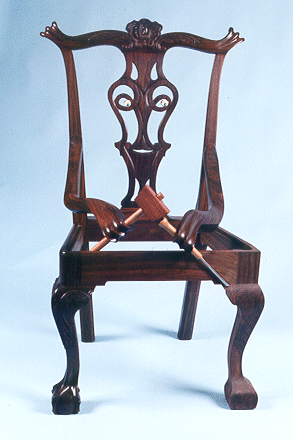Jake Cress & Son
An Irreverant View of the Cultural History of Jake's Animated Furniture
Jake Cress’s infamous “Oops!” chair, with its claw leg reaching for the lost ball, has an honest history in both its original, un-reaching design (the ball and claw foot) and the strange things that furniture makers build. The ball and claw design for a furniture foot was originally designed in Holland around the 1700’s, from whence it migrated to Britain. Chippendale, the builder of many of today’s highly valued antiques, incorporated it into his designs. English furniture makers preferred a lion’s claw; it America, the preferred usage was an eagle’s claw.

Jake Cress: "Oops!,” Renwick Gallery, Smithsonian Museum
Think about language for a minute: chairs have knees, backs, feet, and shoes (the back rail of the chair); cabinets have drawers, knees, and feet, as well as pulls; a cock bead is a finishing molding, and a good piece of furniture might be made of crotch mahogany. The equipment a cabinetmaker uses includes a story stick, a skew tool, a winding stick, and a stroke sander.
How could anyone who knows these descriptions, who works with these tools, not have flights of fancy? The term “studio furniture” came in more than fifty years ago, and refers to one of a kind or of limited edition, hand-crafted furniture.
For example: Oak chest, by Michael Paul, 1950’s

Then there’s Art Furniture, a category that tends to segue into folk art, so we won’t pursue it here, though folk art – often done by unknown artists – tends to be colorful, naïve, and totally delightful. Think painted Pennsylvania Dutch furniture.
There’s Art Deco, an art design movement from 1925 to the ‘40’s, which considered itself efficient and “clean”; it was geometric, and influenced the Flapper age. The Empire State Building is Art Deco. Scandinavian furniture, with its simple lines and light look came from this movement. Pop art came next, in the 1950’s; the idea was that tools of mass-produced popular culture held the same perspective as fine art. Advertising and comic books were some of those tools, and Andy Warhol’s Campbell Soup cans personified the movement.
Post-modern art, which is still out there, is conceptual art, installation art, and performance art. If one were to make a piece of furniture in conceptual art, it would truly be a “think” piece. Or in performance art, you’d have to act like a chair.
But back to furniture makers: Wendell Castle is one of the best-known contemporary furniture craftsmen (often credited with being the father of the studio furniture movement). His Ghost Clock, in the Smithsonian’s Renwick Gallery, is a marvel of tromp l’oeil (fool the eye) and craftsmanship; it looks so much like a tall-case clock draped in a sheet that one wants to touch it to be sure it is, in fact, a solid carved piece of mahogany.
Wendell Castle, Ghost Clock, Smithsonian Renwick Gallery

Craig Nutt is another well-known contemporary furniture maker. He is known for using vegetable images as parts of his furniture: this is his “Pepper Cabinet”:
Banana Pepper Cabinet With Seeds and Fruit, 2001, Corcoran Gallery, Washington, D.C.

Although Jake has been called “warped” by a customer who was expecting only very traditional furniture (which he also builds), he is quite sane in his designs. Most of it is quite utilitarian; only a few pieces qualify as sculpture. Which brings forth the question: is it furniture, or is it sculpture? – and I’m not going there.
Jake Cress, Self-Portrait - sculpture

Jake Cress, "Peel Here" - perfectly functional
